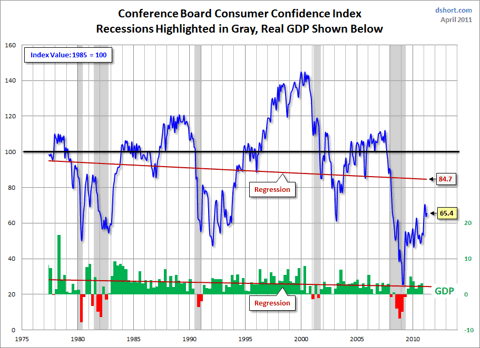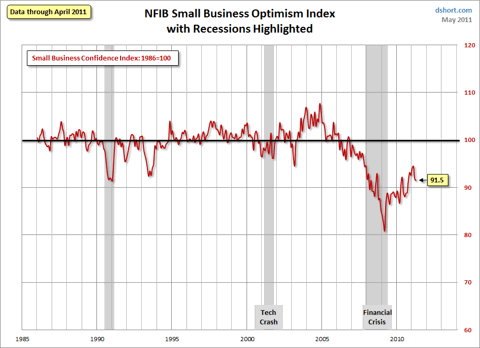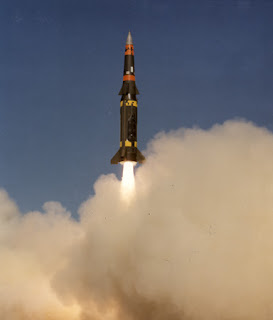Monday, May 30, 2011
Sunday, May 29, 2011
Saturday, May 28, 2011
Michigan Consumer Sentiment Index: More Upside Surprise

 The University of Michigan Consumer Sentiment Index final report for May came in at 74.3, an unexpected improvement over both the April final of 69.8 and the May preliminary reading of 72.4. The Briefing.comconsensus expectation had been for 72.4 and Briefing.com's own forecast was for 72.6. The rise in gasoline prices, often a drag on sentiment, hasn't taken a toll on the mood of the consumer.
The University of Michigan Consumer Sentiment Index final report for May came in at 74.3, an unexpected improvement over both the April final of 69.8 and the May preliminary reading of 72.4. The Briefing.comconsensus expectation had been for 72.4 and Briefing.com's own forecast was for 72.6. The rise in gasoline prices, often a drag on sentiment, hasn't taken a toll on the mood of the consumer.See the chart below for a long-term perspective on this widely watched index. Because the sentiment index has trended upward since its inception in 1978, I've added a linear regression to help understand the pattern of reversion to the trend. I've also highlighted recessions and included real GDP to help evaluate the Michigan Consumer Sentiment Index as an indicator of the broader economy
 To put today's report into the larger historical context since its beginning in 1978, consumer sentiment is about 14% below the average reading (arithmetic mean), 12% below the geometric mean, and 15% below the regression line on the chart above. The current index level is at the 23rd percentile of the 401 monthly data points in this series
To put today's report into the larger historical context since its beginning in 1978, consumer sentiment is about 14% below the average reading (arithmetic mean), 12% below the geometric mean, and 15% below the regression line on the chart above. The current index level is at the 23rd percentile of the 401 monthly data points in this series The Michigan average over since its inception is 86. During non-recessionary years the average is 88.9. The average during the five recessions is 69.3.For the sake of comparison here is a chart of the Conference Board's Consumer Confidence Index (monthly update here). The Conference Board Index is the more volatile of the two, but the general pattern and trend are remarkably similar to the Michigan Index
The Michigan average over since its inception is 86. During non-recessionary years the average is 88.9. The average during the five recessions is 69.3.For the sake of comparison here is a chart of the Conference Board's Consumer Confidence Index (monthly update here). The Conference Board Index is the more volatile of the two, but the general pattern and trend are remarkably similar to the Michigan IndexAnd finally, the prevailing mood of the Michigan survey is also similar to the mood of small business owners, as captured by the NFIB Business Optimism Index (monthly update here).Consumer and small business sentiment remains close to levels associated with other recent recessions, but the trend has been one of general improvement.
Gasoline Prices Erode Incomes, Spending
May 27th, 2011 (0) Posted By Sochea
WASHINGTON (Reuters) – The economy remained sluggish early in the second quarter as high gasoline prices crimped consumer spending and bad weather helped push pending home sales to a seven-month low in April.
Consumer spending increased 0.4 percent for a 10th straight month of gains, the Commerce Department said on Friday, after rising 0.5 percent in March.
But prices rose 0.3 percent, leaving spending up just 0.1 percent and incomes stagnant when adjusted for inflation.
Tornadoes and floods, which lashed parts of the country last month, were blamed in part for an 11.6 percent plunge in contracts to buy previously owned homes last month.
“We see the soft patch of the first quarter bleeding, at least, into the first half of the second quarter,” said Robert Dye, senior economist at PNC Financial Services in Pittsburgh.
“We will see again a consumer that can keep pace with the economy, but cannot drive the economy forward.”
Recent data including retail sales and industrial output have been soft, prompting economists to lower their growth forecasts for the second quarter. Further cuts are likely next week should May auto sales come in very weak.
Second-quarter gross domestic product forecasts are currently ranging between a 2.5 percent and 3 percent rate.
The government reported on Thursday that consumer spending — which accounts for about 70 percent of U.S. economic activity — grew at a tepid 2.2 percent annual rate in the first quarter, slowing from a 4 percent clip in the final three months of 2010.
That contributed to holding back overall economic growth to a 1.8 percent pace during the quarter after a 3.1 percent rate in the October-December period.
With much of the slowdown attributed to what policymakers see as temporary factors, such as high commodity prices and supply chain disruptions because of the earthquake in Japan, the Federal Reserve is not expected to worry too much about the pace of recovery.
The central bank is expected to keep its ultra-easy monetary stance after it wraps up its $600 billion government bond-buying program in June before it start looking at ways to withdraw some of the stimulus it has lent the economy.
INCOMES STAGNANT
U.S. financial markets were little moved on the data. Stocks rose, while government debt prices fell modestly. The dollar fell against a basket of currencies.
The high gasoline prices swallowed almost all the increase in incomes from U.S. tax cuts enacted in December.
Economists worry that stagnant incomes — which have failed to keep up with inflation — will continue to impede spending even though prices at the fuel pump are starting to fall.
So far, consumers have resorted to saving less and some are tapping into their savings to maintain spending. Incomes rose 0.4 percent last month, but disposable incomes adjusted for inflation were flat for a second straight month.
Real incomes have not grown this year and the saving rate stayed at a 2-1/2 year low of 4.9 percent in April. According to the Commerce Department’s chief economist, Mark Doms, Americans saved $82 less over the past four months.
“Consumers have dipped into savings in order to make it through this challenging environment,” said Michael Feroli, an economist at JPMorgan in New York.
“Just as consumers used savings to smooth through the energy price spike on the upside, any move to rebuild saving in the wake of easing gas prices could soften the lift to what otherwise should be a very stimulative development.”
The retreating gasoline price helped to lift consumer spirits this month and dial down their inflation expectations.
The final version of the Thomson Reuters/University of Michigan consumer sentiment survey showed sentiment among Americans rose this month to 74.3 from 72.4 in the preliminary May reading.
The survey’s one-year inflation outlook fell to 4.1 percent from 4.4 percent in April, while expectations for the next five years dipped to 2.9 percent from 3.0 percent.
The national price for regular unleaded gasoline prices slipped to $3.90 a gallon in the week through Monday, according to the Energy Information Administration, after peaking just above $4 a gallon early in the month.
This is giving some economists a reason to be optimistic.
“We are optimistic that the recent easing of gas prices — if it continues — will provide a tailwind to consumption in the coming months,” said Joseph LaVorgna, U.S. chief economist at Deutsche Bank in New York.
High gasoline prices pushed up the year-on-year inflation rate to 2.2 percent, the biggest rise in a year, after increasing 1.8 percent in March.
Excluding food and energy, prices increased 1 percent, the largest gain since September, after rising 0.9 percent in March. Fed officials would like this measure close to 2 percent.
The U.S. Postal Service Nears Collapse
Delivery of first-class mail is falling at a staggering rate. Facing insolvency, can the USPS reinvent itself like European services have—or will it implode?
Delivery of first-class mail is falling at a staggering rate. Facing insolvency, can the USPS reinvent itself like European services have—or will it implode?

Phillip Herr looks like many of the men who toil deep within the federal government. He wears blue suits. He keeps his graying hair and mustache neatly trimmed. He has an inoffensively earnest manner. He also has heavy bags under his eyes, which testify to the long hours he spends scrutinizing federal spending for the U.S. Government Accountability Office, the congressional watchdog agency where he is Director of Physical Infrastructure Issues. As his title suggests, Herr devotes much of his time to highway programs. But for the past three years he has been diagnosing what ails the U.S. Postal Service.
It's a lonely calling. "Washington is full of Carnegie and Brookings Institutes with people who can tell you every option we have in Egypt or Pakistan," laments Herr, who has a PhD in anthropology from Columbia University. "Try and find someone who does that on the postal service. There aren't many."
Yet Herr finds the USPS fascinating: ubiquitous, relied on, and headed off a cliff. Its trucks are everywhere; few give it a second thought. "It's one of those things that the public just takes for granted," he says. "The mailman shows up, drops off the mail, and that's it."
He is struck by how many USPS executives started out as letter carriers or clerks. He finds them so consumed with delivering mail that they have been slow to grasp how swiftly the service's financial condition is deteriorating. "We said, 'What's your 10-year plan?' " Herr recalls. "They didn't have one."
Congress gave him until the end of 2011 to report on the USPS's woes. But Herr and his team concluded that the postal service's business model was so badly broken that collapse was imminent. Abandoning a long tradition of overdue reports, they felt they had to deliver theirs 18 months early in April 2010 to the various House and Senate committees and subcommittees that watch over the USPS. A year later, the situation is even grimmer. With the rise of e-mail and the decline of letters, mail volume is falling at a staggering rate, and the postal service's survival plan isn't reassuring. Elsewhere in the world, postal services are grappling with the same dilemma—only most of them, in humbling contrast, are thriving.
The USPS is a wondrous American creation. Six days a week it delivers an average of 563 million pieces of mail—40 percent of the entire world's volume. For the price of a 44¢ stamp, you can mail a letter anywhere within the nation's borders. The service will carry it by pack mule to the Havasupai Indian reservation at the bottom of the Grand Canyon. Mailmen on snowmobiles take it to the wilds of Alaska. If your recipient can no longer be found, the USPS will return it at no extra charge. It may be the greatest bargain on earth.
It takes an enormous organization to carry out such a mission. The USPS has 571,566 full-time workers, making it the country's second-largest civilian employer after Wal-Mart Stores (WMT). It has 31,871 post offices, more than the combined domestic retail outlets of Wal-Mart, Starbucks (SBUX), and McDonald's (MCD). Last year its revenues were $67 billion, and its expenses were even greater. Postal service executives proudly note that if it were a private company, it would be No. 29 on the Fortune 500.
The problems of the USPS are just as big. It relies on first-class mail to fund most of its operations, but first-class mail volume is steadily declining—in 2005 it fell below junk mail for the first time. This was a significant milestone. The USPS needs three pieces of junk mail to replace the profit of a vanished stamp-bearing letter.
During the real estate boom, a surge in junk mail papered over the unraveling of the postal service's longtime business plan. Banks flooded mailboxes with subprime mortgage offers and credit-card come-ons. Then came the recession. Total mail volume plunged 20 percent from 2006 to 2010.
Friday, May 27, 2011
Nissan takes a crack at Volt hybrid electric car
Nissan fired the opening salvo at General Motors by taking a crack at its plug-in electric hybrid Chevy Volt in an advertisement for its pure plug-in electric car, the Nissan Leaf.
The advertisement mocks cars that use internal combustion engines and gasoline by showing a world where any electronic gadget is powered by gasoline and an internal combustion engine. The results are comically outlandish — the commercial even features an iPod-esque music device powered by an internal combustion engine and a laptop that needs a gasoline fill-up.
Nissan lumps the Chevy Volt, a plug-in electric hybrid that drives the first 30 or so miles off battery power before shifting to an internal combustion engine to extend the car’s range, into that group of gadgets and devices that are polluting the planet with gasoline use. The advertisement is the first major sign of a growing competition between Nissan and General Motors to attract car buyers that are interested in more fuel-efficient cars. They’re taking a different approach because Nissan is focusing on creating a pure electric car while General Motors wants to create a car that is more fuel-efficient but has the same range as a typical car.
Most of the concerns for electric car buyers center around how long it takes to charge the car and how far it is able to drive, according to a report by Accenture. Electric cars are typically limited in how far they will go on a charge, and they can take a long time to recharge. It can take up to 5 hours for some vehicles to charge completely from a dry battery to a full charge.
The Volt has a traditional internal combustion engine and an engine powered by a battery jammed into the same vehicle. The car can run around 35 miles off battery power before the internal combustion engine kicks in, giving the car a total range north of 300 miles on a full charge and full tank of gas. It’s one of the cheaper electric cars on the market. The Nissan Leaf — another one of the cheapest electric cars on the market — is a pure electric car that can travel around 100 miles before it needs to recharge.
Nissan’s plug-in electric car, the Leaf, outsold General Motors’ Volt electric car for the first time in April — the first results of Nissan aggressively expanding its production of the Leaf to meet an almost insatiable demand for the electric car. Before April, GM’s Volt had consistently outperformed the Nissan Leaf each month until April. Electric car buyers bought 326 Volts the month after the car went on sale, compared to 19 Nissan Leafs sold that same month. GM sold 608 Volts in March.
The 2011 Nissan Leaf sells for $32,780 while the 2011 Chevy Volt costs around $41,000. Electric car buyers can apply for a federal tax credit that can bring the price down by $7,500. They’re both designed to attract more mainstream car buyers that are looking for a more environmentally friendly option or want to save money on the cost of gas. The Nissan Leaf can travel around 100 miles before needing to recharge and has an equivalent fuel efficiency of 99 miles per gallon. The Chevy Volt has an equivalent fuel efficiency rating of 93 miles per gallon.

































































































































